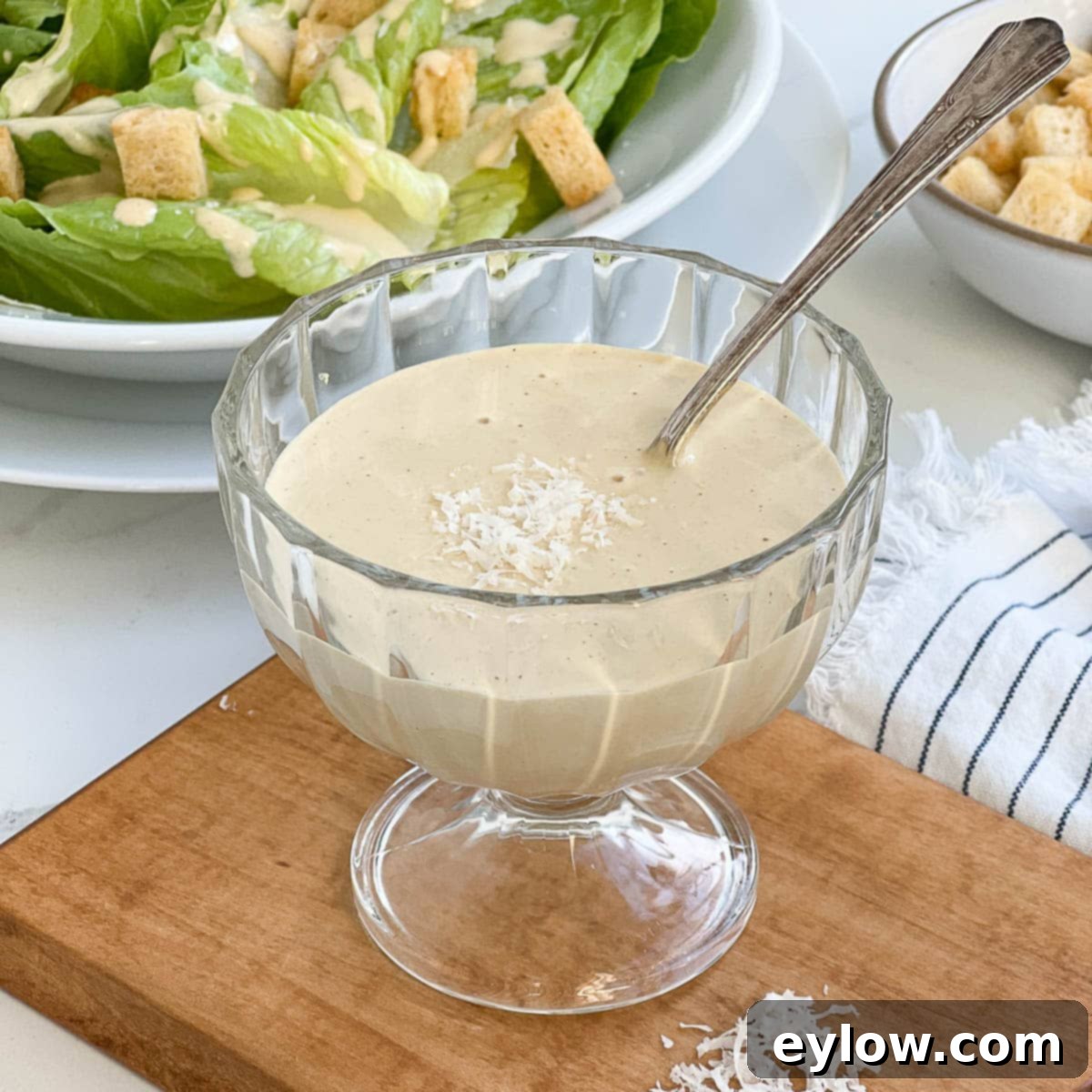The Best Easy & Creamy Homemade Caesar Dressing Without Anchovies
Say goodbye to store-bought bottles and hello to a culinary revelation! This homemade Caesar salad dressing without anchovies is so incredibly rich, creamy, and bursting with authentic flavor that you’ll wonder why you ever settled for anything less. Crafted in just minutes with the help of a blender, this recipe isn’t just a hit for classic Caesar salads; it’s a versatile flavor enhancer that elevates grilled vegetables, sandwiches, wraps, and even roasted chicken. The best part? You can easily achieve that signature bold, tangy taste and velvety texture without a single anchovy in sight. Prepare to transform your meals and delight your taste buds with this effortlessly delicious dressing.
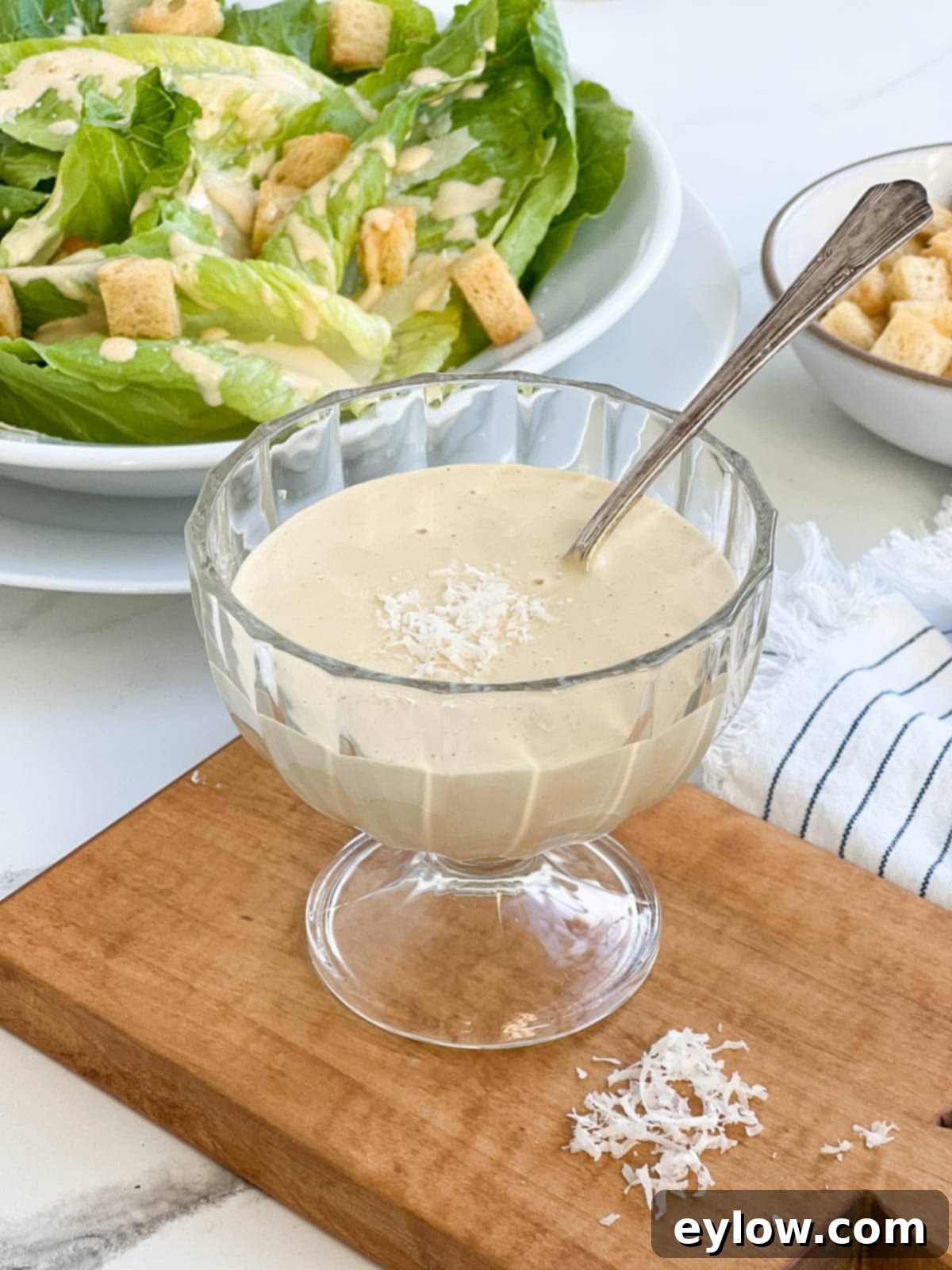
The iconic appeal of Caesar salad dressing lies in its distinctive creamy texture and bold, savory-tangy profile. Many believe anchovies are indispensable for achieving this depth, but this recipe proves otherwise. Our anchovy-free Caesar dressing is luxuriously rich, perfectly tangy, and comes together in practically no time using a blender. While it’s absolutely phenomenal on traditional romaine lettuce, its versatility shines when drizzled over other leafy greens, steamed vegetables, or even as a marinade. Once you experience the vibrant freshness and superior taste of homemade, you’ll agree that bottled dressings simply can’t compare.
[feast_advanced_jump_to]
Essential Ingredients for Your Homemade Caesar Dressing
Creating an outstanding Caesar dressing starts with selecting quality ingredients. Each component plays a vital role in building the complex, balanced flavor and irresistible creamy consistency. Here’s a detailed look at what you’ll need and why each element is so important:
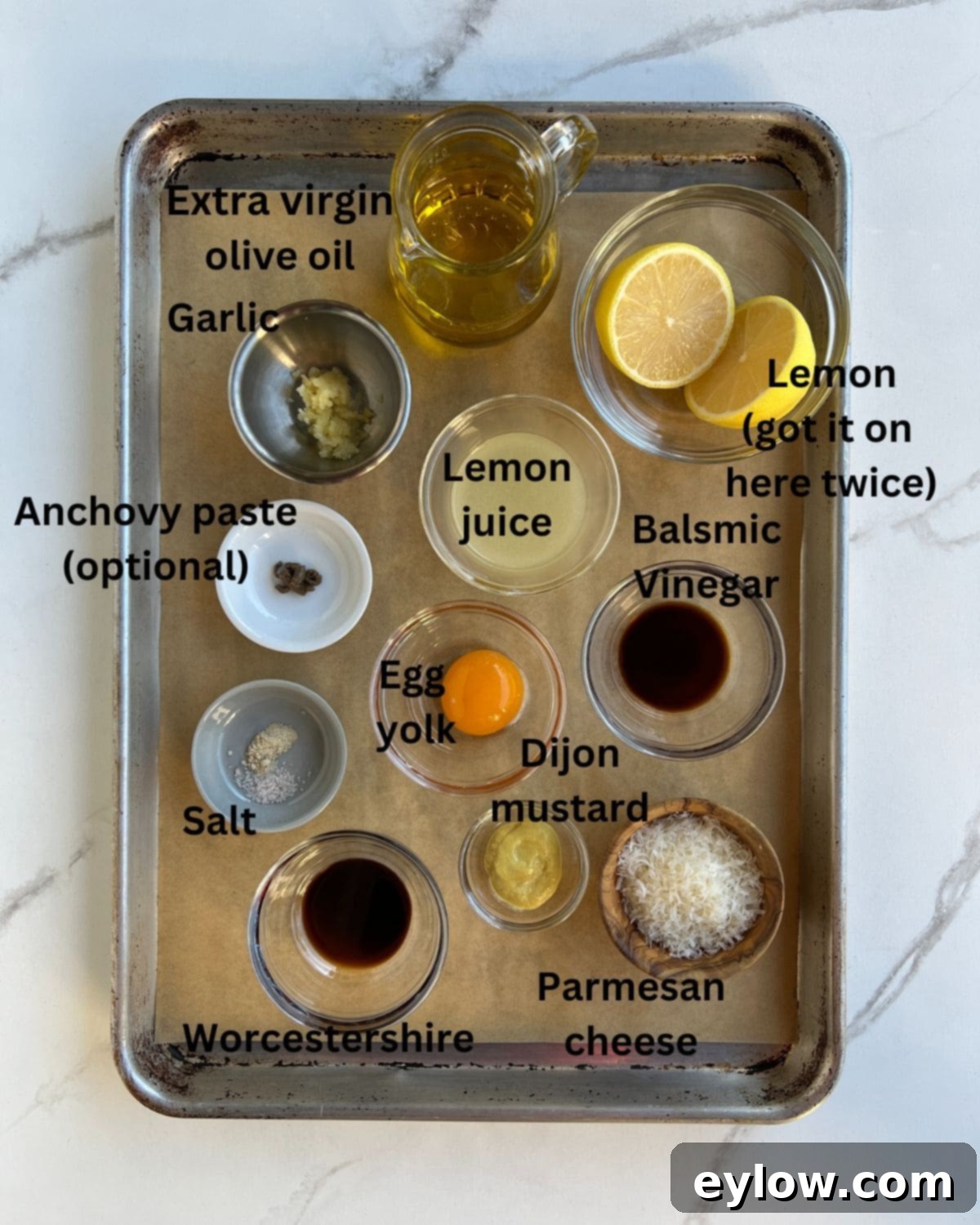
- Fresh Lemon Juice: This is a non-negotiable ingredient. Freshly squeezed lemon juice provides the essential bright, zesty tang that cuts through the richness of the dressing. It also plays a crucial role in balancing the other savory elements. Always opt for fresh over bottled for the most vibrant flavor.
- Large Egg Yolk: The egg yolk is key to achieving that signature creamy, emulsified texture. It acts as a natural emulsifier, binding the oil and other liquids together to form a smooth, homogeneous dressing. Don’t worry about using raw egg; we’ll cover safety tips below.
- Dijon Mustard: A cornerstone of classic Caesar dressing, Dijon mustard offers a subtle, piquant heat and a tangy depth. Beyond flavor, it’s an excellent natural emulsifier, further aiding in the dressing’s creamy consistency. Any good quality Dijon will work beautifully.
- Anchovy Paste (Optional): I often avoid whole anchovies, but surprisingly, a tiny bit of anchovy paste (from a tube) can add a profound depth of savory, umami flavor without any noticeable “fishiness.” It’s an optional addition, and if you’re truly opposed, the dressing will still be fantastic without it. However, if you’re curious about adding that traditional umami punch, give it a try – you might be pleasantly surprised!
- Fresh Garlic: For a truly bold and aromatic dressing, fresh garlic is paramount. Grate it finely or smash it into a paste to ensure its potent flavor is evenly distributed throughout the dressing. Avoid garlic powder for this recipe; fresh makes all the difference.
- Balsamic Vinegar: While not traditionally found in every Caesar dressing, balsamic vinegar adds a wonderful layer of complexity. Its slightly sweet, rich, and fruity notes complement the tang of the lemon and the savoriness of the other ingredients, adding a unique depth that makes this recipe stand out.
- Worcestershire Sauce: This is an absolute Caesar essential. Worcestershire sauce delivers a complex savory, slightly fermented, and umami flavor that is characteristic of a great Caesar dressing. It’s a blend of flavors that you just can’t replicate with a single ingredient.
- Extra Virgin Olive Oil: The foundation of your dressing, the olive oil binds all the flavors together. Choose a good quality, smooth extra virgin olive oil. Its flavor profile will impact the overall taste of your dressing, so avoid anything too bitter or overly strong.
- Parmesan Cheese: Finely grated Parmesan cheese adds a salty, nutty, and savory dimension to the dressing, enhancing its richness and providing a slight textural body. Always grate fresh Parmesan for the best flavor; pre-grated varieties often contain anti-caking agents that can affect texture and taste.
Specific measurements for all ingredients, along with salt and pepper, are provided in the comprehensive recipe card below. Remember to taste and adjust seasonings to your personal preference!
Chef’s Tip on Gluten-Free Worcestershire: Many popular Worcestershire sauce brands, such as Lea & Perrins Original, Wizard’s Classic, and French’s, are naturally gluten-free, even if their labels don’t explicitly state it. This is due to the low concentration of gluten-containing ingredients like malt vinegar, which is often derived from barley. However, for complete peace of mind, especially if you have severe sensitivities, it’s always best to check the manufacturer’s website or contact their customer service line directly for the most up-to-date and accurate information regarding allergens. You can also find certified gluten-free versions readily available in most grocery stores and online.
Creative Substitutions and Exciting Variations
This Caesar dressing recipe is incredibly flexible, allowing for delightful variations and thoughtful substitutions to suit different tastes or dietary needs. Don’t be afraid to experiment and make it your own!
- Cheese Alternatives: If you’re out of Parmesan or want to try something different, consider Mexican Cotija cheese. It’s wonderfully salty and crumbly, offering a similar savory depth. Just be mindful of its saltiness and adjust any added salt accordingly. For a dairy-free option, nutritional yeast or vegan Parmesan alternatives work exceptionally well, providing a cheesy umami flavor.
- Oil Choices: Extra virgin olive oil is classic, but if you’re not a fan or prefer a more neutral taste, avocado oil is an excellent healthy alternative. For a truly neutral-tasting oil that’s not a processed vegetable oil, look for cultured oils like those from Spectrum Organics. Many find these oils to be a fantastic pantry staple alongside olive oil. You can also blend oils, using half olive oil and half of another preferred oil to balance flavors.
- Mustard Swaps: Dijon mustard provides a specific tang and subtle spice, but your favorite mustard can be used in a pinch. Just be aware that the flavor profile of the dressing will shift. A spicy brown mustard will add more kick, while a milder yellow mustard will result in a less complex taste.
- Citrus Twist: For a unique and slightly more acidic flavor profile, swap out the lemon juice for fresh lime juice. Limes are generally more acidic and offer a distinctively bright, slightly floral note that pairs wonderfully with the other savory ingredients, particularly if you’re aiming for a “Mexican Caesar” twist.
- Adjusting Consistency: If your dressing turns out too thick after blending, don’t fret! Simply thin it down gradually by adding small amounts of water or a bit more lemon juice until it reaches your desired pourable consistency. Add a teaspoon at a time and blend, then check.
- Leafy Green Alternatives: Romaine lettuce is the traditional choice for Caesar salad, but this robust dressing pairs beautifully with a variety of other greens. Try sturdy kale leaves (massaged lightly), peppery arugula, delicate spinach, or thinly sliced Napa cabbage for a different texture and flavor experience.
Chef’s Tip for Salad Pairing: A good rule of thumb for successful salad making is to match the strength of your dressing to the sturdiness of your greens. Creamier, richer dressings like this Caesar are best suited for sturdy leaves such as romaine, kale, or cabbage. Conversely, lighter, more fluid vinaigrettes pair better with delicate, softer leaves like butter lettuce or tender spring mixes.
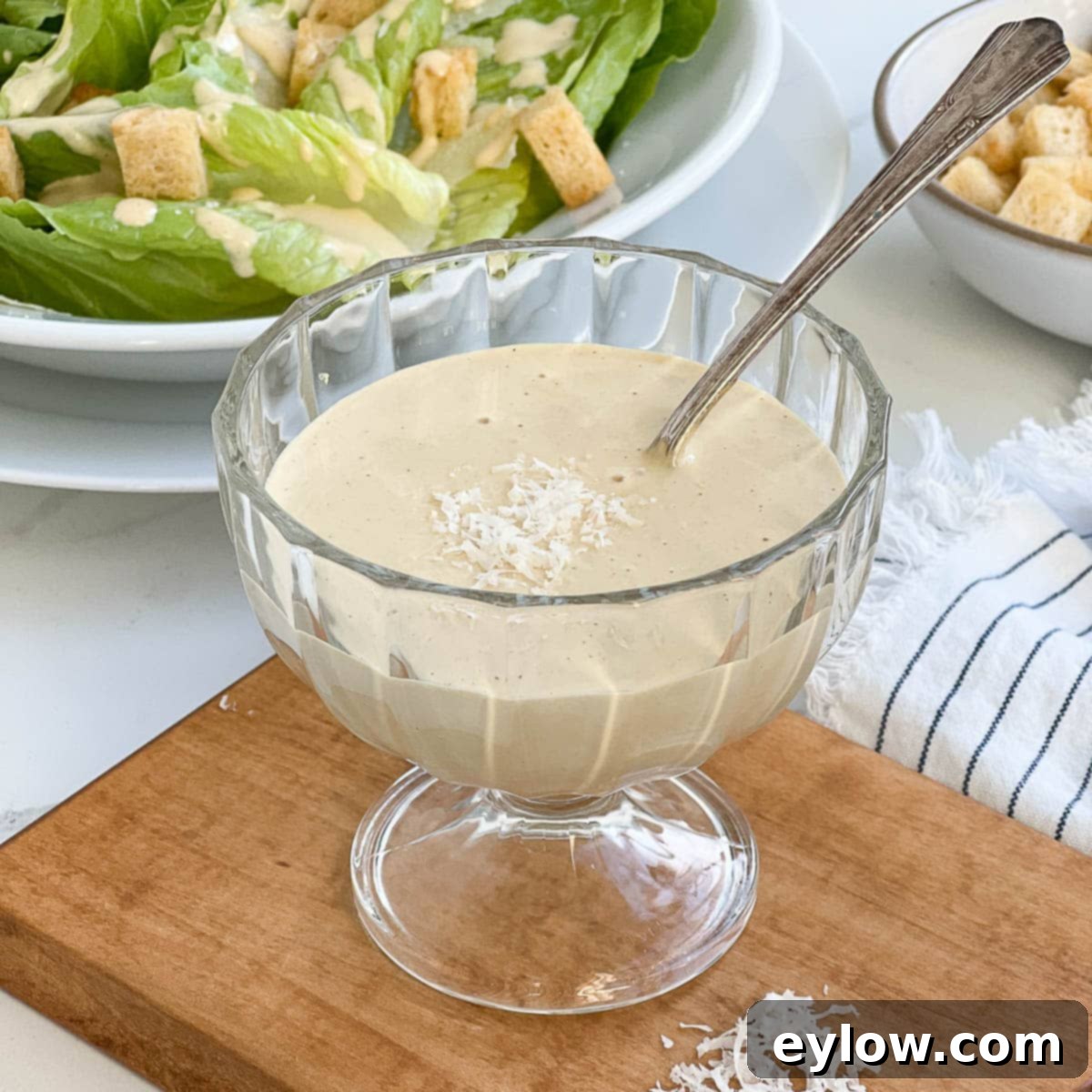
Important Ingredient Considerations
Chef’s Tip: Using Raw Egg Yolk Safely: The use of raw egg yolk is traditional in Caesar dressing and contributes significantly to its rich, creamy texture and emulsification. If your eggs are clean, fresh, uncracked, and have been properly refrigerated, and if you are not pregnant, elderly, very young, or immunocompromised, consuming them raw is generally considered safe. Many home cooks, myself included, use raw yolks without issues. For an extra layer of peace of mind, especially if serving to a vulnerable individual or large group, look for pasteurized eggs. These eggs have been gently heated in their shells to eliminate potential bacteria like Salmonella without cooking the egg, making them a safer choice for raw applications. Always purchase eggs from a refrigerated section, check for cracks before use, and store them promptly in the fridge. The only exception to refrigeration is unwashed farm-fresh eggs, which retain their natural protective “bloom” and can be stored at room temperature for a period, though refrigeration is still recommended for longer storage or after washing. For detailed food safety guidelines and information on who is at higher risk for Salmonella infection from raw eggs, consult reputable sources like the Centers for Disease Control (CDC) or your local agricultural extension office. While statistics suggest that only about 1 in 20,000 eggs may contain Salmonella, it’s always wise to prioritize what feels safest for your family.
How to Make Homemade Caesar Dressing
Making homemade Caesar salad dressing without anchovies is surprisingly simple and quick, especially with the right tools. You can achieve a beautifully creamy dressing using either a blender or by hand. The blender method is undeniably faster and typically yields a smoother, more consistently emulsified result. An immersion blender (stick blender) works equally well; for best emulsification with an immersion blender, use a tall, narrow container.
Blender Method: Achieve Perfect Creaminess in Minutes
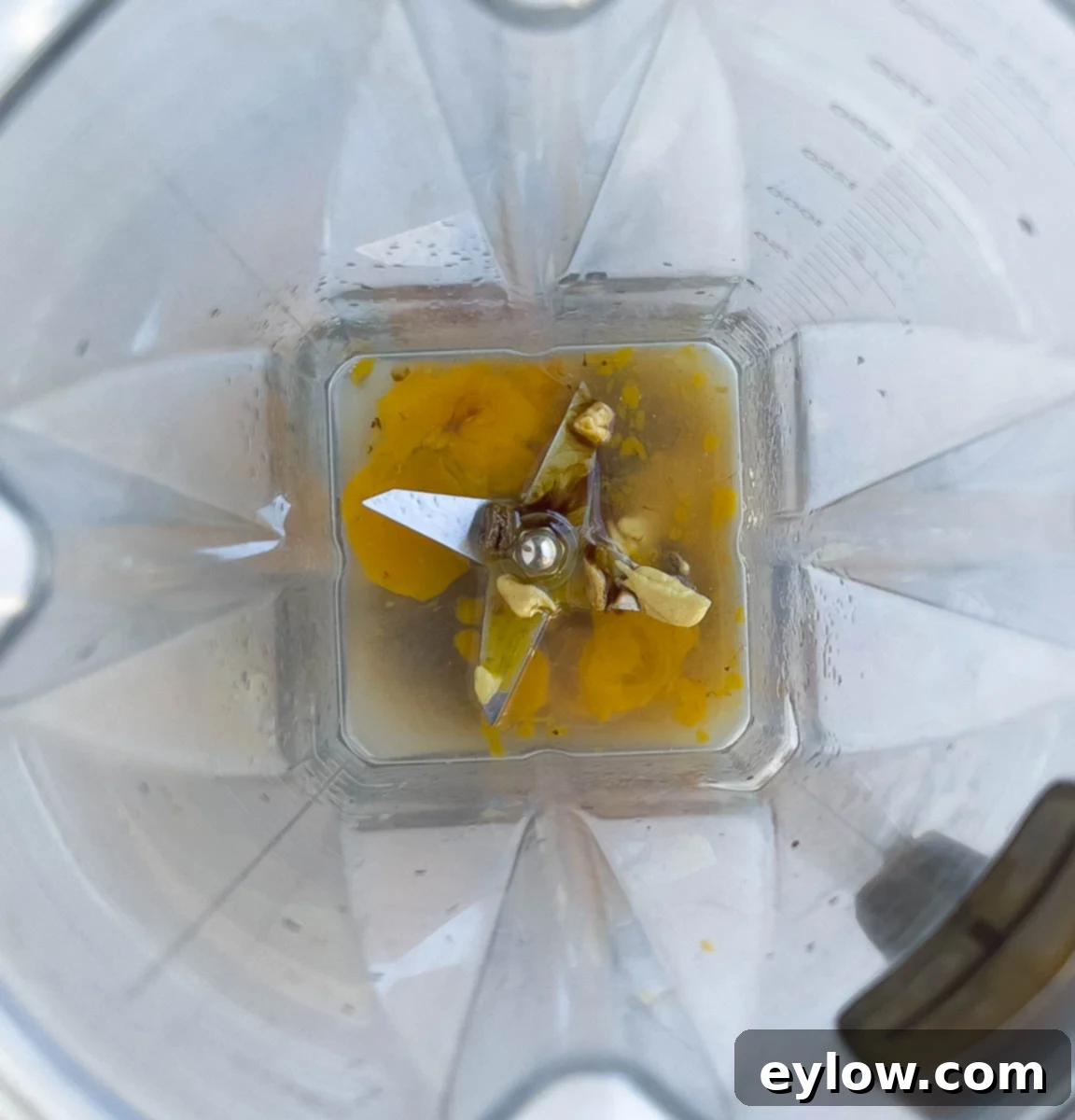
The blender method is ideal for those seeking maximum creaminess with minimal effort. The high speed of the blender helps to quickly and efficiently emulsify the oil into the other ingredients.
Step 1: Combine Initial Ingredients. Into your blender, add the lemon juice, egg yolk, Dijon mustard, anchovy paste (if you choose to use it), minced garlic, balsamic vinegar, and Worcestershire sauce. Secure the lid, but if your blender has a removable center cap, ensure it’s open. Pulse or puree on the lowest speed for a few seconds until these ingredients are well combined and smooth. This initial blend ensures all the core flavors are integrated before the oil is added.
Step 2: Slowly Emulsify with Oil. With the blender still running on a low speed, begin to slowly drizzle the extra virgin olive oil through the center opening of the lid. The key here is patience and a slow, steady stream. This gradual addition allows the egg yolk and mustard to emulsify the oil into tiny droplets, creating a stable, creamy dressing rather than a separated, oily mixture. As the dressing begins to thicken and emulsify, you can increase the blender speed slightly and pour the oil a little faster. Continue blending until all the oil is incorporated and the dressing is thick and creamy.

Step 3: Add Parmesan and Adjust. Once the dressing is thick and creamy, add the finely grated Parmesan cheese. Briefly pulse the blender again until the cheese is fully incorporated and the dressing is uniformly smooth. Taste the dressing and adjust seasonings as needed. You might want a little more lemon juice for extra tang, a pinch more salt, or a grind of fresh black pepper to enhance the flavors. If the dressing is too thick, add a teaspoon of warm water or extra lemon juice at a time until the desired consistency is achieved.
Traditional Hand Whisking Method
While a blender offers convenience, a beautifully emulsified Caesar dressing can absolutely be made by hand. This method requires a bit more arm strength and patience, but the results are equally rewarding, often with a slightly rustic texture.
Step 1: Prepare Your Workspace. To successfully whisk by hand, you’ll need both hands free. Stabilize a medium-sized mixing bowl by setting it on a damp kitchen towel curled into a ring on your countertop. This prevents the bowl from sliding around as you whisk vigorously.
Step 2: Whisk Initial Ingredients. Place the egg yolk, Dijon mustard, and lemon juice into the stabilized bowl. Whisk these ingredients together strongly and continuously until they are smooth and slightly pale. This initial whisking helps to build a strong base for your emulsion.
Step 3: Slowly Drizzle and Emulsify Oil. This is the most crucial step for hand-whisking. Begin to very slowly, almost drop by drop, drizzle the extra virgin olive oil into the bowl while whisking constantly and vigorously. Maintain a consistent, steady whisking motion. As the dressing starts to thicken and lighten in color (indicating the emulsion is forming), you can gradually increase the speed at which you add the oil. Continue until all the oil has been incorporated and the dressing is thick and creamy. It should have a mayonnaise-like consistency.
Step 4: Incorporate Cheese and Season. Once the emulsion is stable and creamy, whisk in the finely grated Parmesan cheese until it’s smoothly integrated into the dressing. Taste the dressing and adjust the seasoning. Add more lemon juice for brightness, salt for overall flavor, and fresh ground black or white pepper to your liking. If it feels too thick, a tiny splash of warm water or lemon juice can help achieve your preferred consistency.
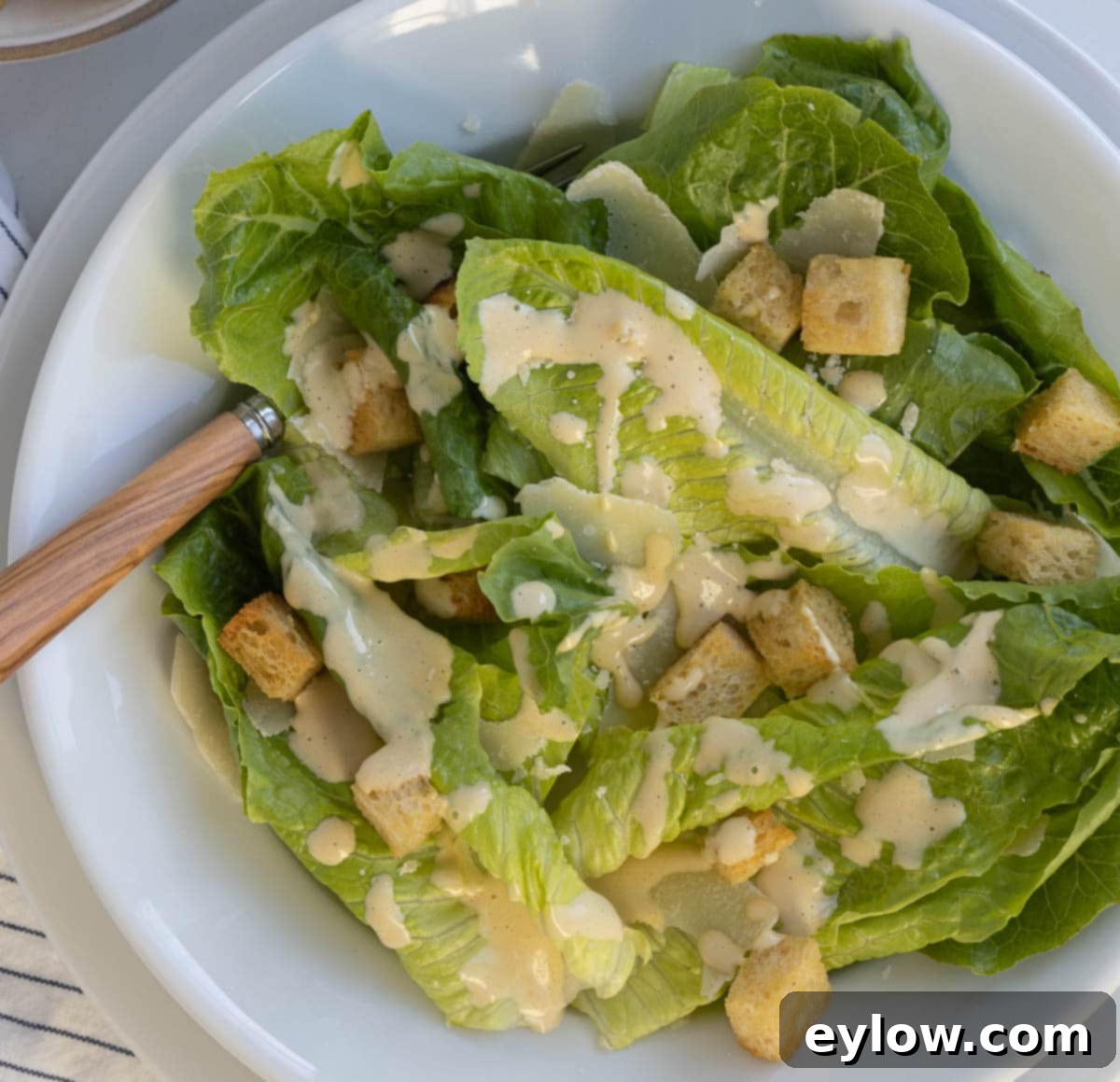
Creative Serving Suggestions for Your Caesar Dressing
This homemade Caesar dressing is incredibly versatile and can be used in countless ways beyond the classic salad. Here are some ideas to inspire your culinary creativity:
For a traditional Caesar salad, simply chop crisp Romaine lettuce crosswise into elegant ribbons or into convenient bite-sized pieces. Drizzle generously with your freshly made dressing. Alternatively, for a more dramatic presentation, you can use whole hearts of Romaine, serving them as wedges to be cut by the diner at the table.
- The Classic Caesar: Enhance your salad with crunchy croutons and a generous sprinkling of grated or shaved Parmesan cheese. To transform it into a satisfying main dish, add grilled shrimp, thinly sliced grilled chicken breast, or even pan-seared salmon.
- Mexican-Inspired Caesar: Give your Caesar salad a vibrant Southwestern twist. In place of traditional croutons, try crisp tortilla chips or homemade baked tortilla strips. Garnish with a sprinkle of toasted pumpkin seeds (pepitas) and a generous handful of chopped fresh cilantro for a burst of authentic flavor. Adding finely sliced red onions, sweet corn kernels, or colorful strips of bell peppers can also elevate this variation.
- Beyond the Salad Bowl:
- Marinade: Use this flavorful dressing as a marinade for chicken, fish, or pork before grilling or baking. The lemon and vinegar tenderize, while the garlic and Parmesan infuse incredible taste.
- Vegetable Drizzle: Drizzle over roasted vegetables like asparagus, broccoli, or Brussels sprouts after they come out of the oven. It adds a bright, savory finish.
- Dip: Serve it as a creamy dip for fresh vegetable sticks, pita bread, or even potato chips.
- Sandwiches & Wraps: Spread a thin layer inside sandwiches, wraps, or pita pockets for an extra boost of flavor. It pairs wonderfully with turkey, chicken, or vegetarian fillings.
- Pasta Salad Base: Mix with cooked and cooled pasta, cherry tomatoes, cucumbers, and grilled chicken for a delicious and easy pasta salad.
- Homemade Croutons: For the absolute best Caesar salad experience, skip the store-bought croutons. Homemade garlicky, gluten-free croutons are incredibly easy to make from day-old bread, toasted with olive oil and garlic. Their crisp texture and fresh garlic flavor are unparalleled.
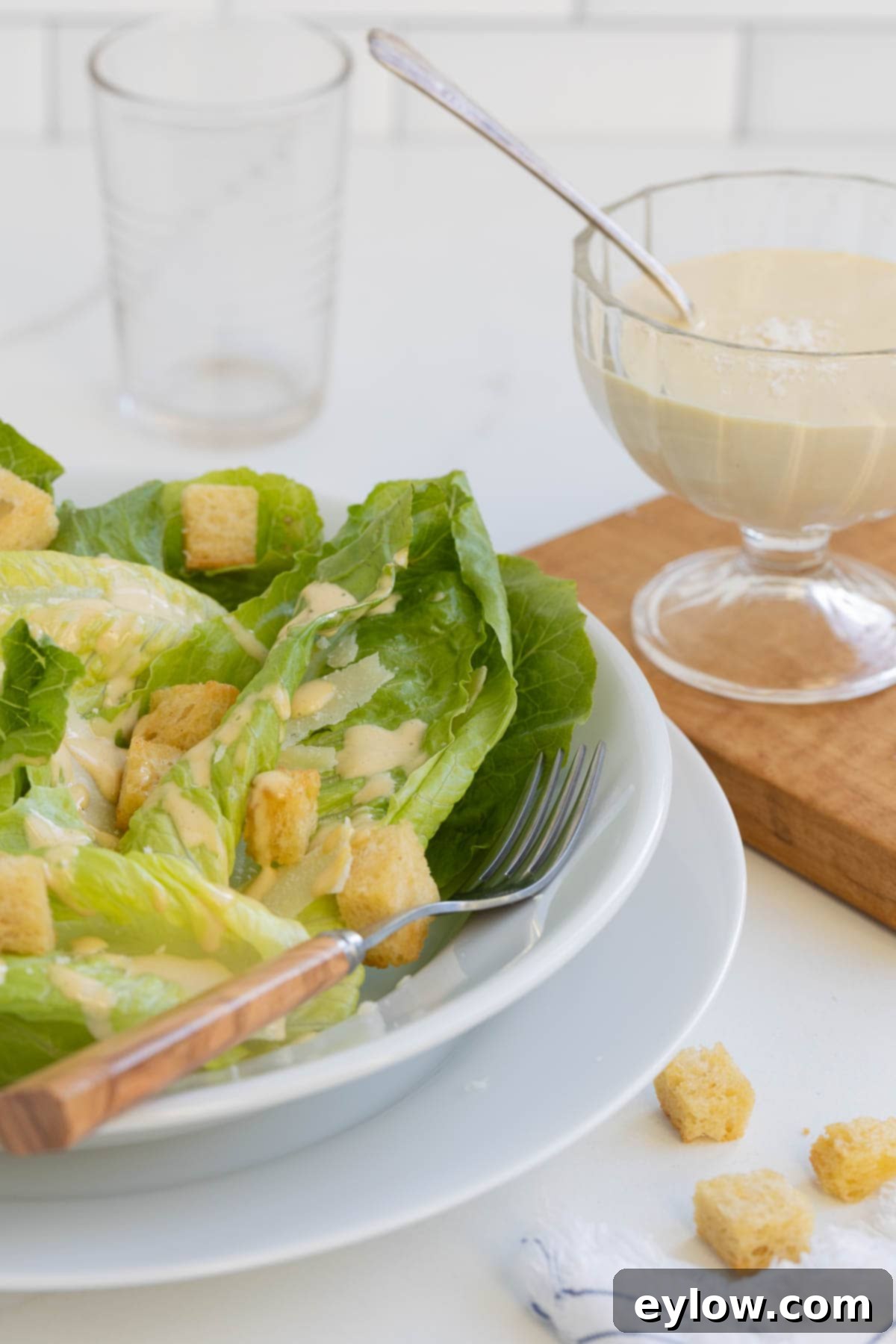
Storage Guidelines for Homemade Caesar Dressing
Due to the raw egg yolk present in this recipe, proper storage and attention to shelf life are crucial for food safety. Always store your homemade Caesar dressing in a sealed jar or an airtight container with a tightly fitting lid immediately after preparation. It should be kept well chilled in the refrigerator. For optimal freshness and safety, consume the dressing within 2-3 days. While some sources might suggest slightly longer, the presence of raw egg yolk makes it a perishable item. If you have a blender, it’s so quick and easy to whip up a fresh batch, making it preferable to keep it fresh rather than risking an older dressing. If your dressing is older than 3 days, it’s best to err on the side of caution and discard it to ensure food safety.
Recipe FAQs
If your freshly made Caesar dressing comes out thicker than you prefer, it’s an easy fix! You can thin it down gradually by adding a very small amount of water or a little more fresh lemon juice. Start with just a teaspoon at a time, blend or whisk it in thoroughly, and then check the consistency. Continue adding in small increments until you reach your desired pourable texture. Be careful not to add too much liquid at once, as it can quickly become too thin.
Absolutely, yes! This entire recipe is designed specifically for making a fantastic Caesar dressing without anchovies. If the thought of anchovies sends you running, you have two excellent choices. You can completely omit them, and the dressing will still be rich, tangy, and incredibly delicious thanks to the other powerful flavors like Worcestershire, Parmesan, and garlic. Alternatively, for those who want that subtle traditional umami depth without any actual fishiness, I highly recommend using just a tiny bit of anchovy paste from a tube. Many people, including myself, who are not fans of whole anchovies, find that a small amount of the paste adds an undetectable savory complexity that truly rounds out the classic Caesar flavor. It’s truly a secret weapon for achieving that authentic taste without tasting the anchovy itself.
Yes, it’s entirely possible to create a delicious dairy-free Caesar dressing. The main dairy component is Parmesan cheese. You can substitute this with either a high-quality vegan Parmesan alternative, which is widely available in many health food stores and larger supermarkets, or by using nutritional yeast. Nutritional yeast is a deactivated yeast powder that has a distinctive savory, cheesy flavor without containing any dairy. It’s often used by vegans to replicate cheese flavors in various dishes. Beyond its flavor, nutritional yeast has a bright yellow color, which will also contribute a lovely golden hue to your dairy-free Caesar dressing. You can find nutritional yeast in most health food sections of grocery stores or easily purchase it online.
More Terrific Salad & Dressing Recipes to Explore
If you loved this homemade Caesar dressing, you’ll be thrilled to discover a world of other easy and delicious vinaigrettes and salads. Explore more options on our dedicated salads and dressings recipe index page. Here are a few reader favorites:
- Healthy Chinese Chicken Salad with Ginger Dressing
- Refreshing Fennel Orange Salad with Zesty Orange Vinaigrette
- Delicious Blueberry Balsamic Vinaigrette
- Gourmet Fig Salad with Goat Cheese and Honey Balsamic Vinaigrette
⭐️ Did You Make This Recipe?
If you take the plunge and whip up this incredible Caesar salad dressing without anchovies, we would absolutely love to hear from you! Your feedback is invaluable and truly helps other home cooks discover and enjoy this recipe. Please share your experience by adding your comment below. If you loved it as much as we do, a 5-star rating would be greatly appreciated and goes a long way in supporting our community!
📖 Recipe
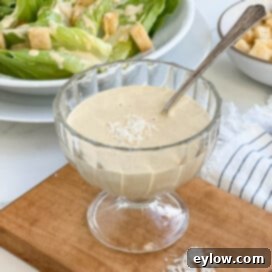
Homemade Creamy Caesar Dressing Without Anchovies
Sally Cameron
Pin Recipe
Equipment
-
Blender (or immersion blender)
Ingredients
- 3 tablespoons fresh squeezed lemon juice
- 1 large egg yolk
- 1 teaspoon Dijon mustard
- ½ teaspoon anchovy paste in a tube (optional, for extra umami depth without fishiness)
- 1 garlic clove finely chopped or minced
- 1 teaspoon Worcestershire sauce
- ½ teaspoon balsamic vinegar
- ½ cup extra virgin olive oil
- 2 tablespoon finely grated Parmesan cheese (or Mexican Cotija for a twist)
- 1 pinch sea salt (to taste)
- 1 pinch white pepper (or black pepper, to taste)
Instructions
-
1. Prepare the Base: Place the fresh lemon juice, egg yolk, Dijon mustard, anchovy paste (if using), minced garlic, balsamic vinegar, and Worcestershire sauce into your blender. Secure the lid. If your blender has a removable center cap, ensure it is open. Puree on the lowest speed for a few seconds until all these ingredients are thoroughly blended and smooth.
2. Emulsify the Oil: With the blender top securely on and the center cap removed, begin to slowly stream the extra virgin olive oil into the blender. Pour it in a thin, steady drizzle. As the oil is gradually incorporated, the dressing will start to thicken and become creamy and emulsified. Increase the blender speed slightly as more oil is added and the emulsion becomes stable. Continue until all the oil is fully blended and the dressing has a rich, velvety consistency.
3. Add Parmesan and Adjust: Once the dressing is thick and creamy, add the finely grated Parmesan cheese. Pulse the blender briefly until the cheese is completely integrated and the dressing is uniformly smooth.
4. Final Seasoning and Consistency: Taste the dressing and adjust with more salt, pepper, or lemon juice if desired. If the dressing is too thick for your preference, add a small amount of warm water or additional lemon juice, a teaspoon at a time, and blend until you achieve the perfect pourable consistency.
